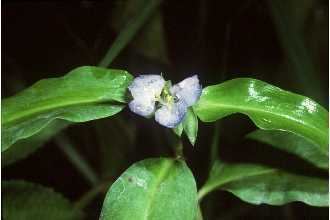Tribe Commelineae Scientific name Commelina virginica Rank Species | Subfamily Commelinoideae Genus Commelina Higher classification Commelina | |
 | ||
Similar Commelina, Commelinaceae, Commelinids, Commelina caroliniana, Commelina diffusa | ||
Commelina virginica, commonly known as the Virginia dayflower, is a perennial herbaceous plant in the dayflower family. It is native to the mideastern and southeastern United States, where it is typical of wet soils. While most members of the genus have thin, fibrous roots, the Virginia dayflower is relatively unique for its genus in having a perennial rhizome. The plant was first described by Carolus Linnaeus in his 1762 publication of the second edition of Species Plantarum. A phylogenetic study based on the nuclear ribosomal DNA region 5S NTS and the chloroplast region trnL-trnF, two commonly used gene regions for determining relationships, suggested that Commelina virginica is most closely related to two African species, namely Commelina capitata and Commelina congesta. However, the statistical support for this result was low. morphologically speaking the supposedly related species do share some unique traits. C. virginica and C. capitata have red hairs at the top of their leaf sheaths, an unusual character in the genus, while C. virginica and C. congesta both have clustered inflorescences on very short stalks.



